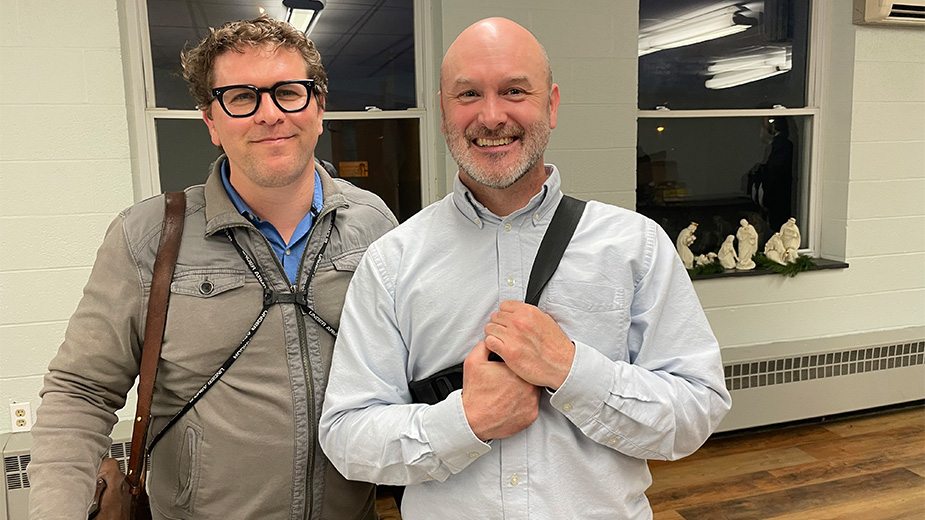Our Towns: Warren Has Rich, Revolutionary Past
WARREN, Ohio — The names on most of the headstones have long been wiped clean by the elements, and mere fragments remain of the identities of those who lived more than two centuries ago. Grass grows high in places, weeds have consumed some of the smaller monuments, and in one case a large tree has uprooted one of the grave markers in an old cemetery that straddles the east bank of the Mahoning River.
Were it not for a historic marker along Mahoning Avenue in Warren, no one would know the Old Mahoning Pioneer Cemetery exists, now obsure from the road by the American Red Cross building under renovation and houses that line the street.
But it’s along this elbow of the Mahoning River where the city of Warren comes face-to-face with its early American heritage. Buried here are people who lived as early as 1727, the year Oliver Brooks was born. He went on to serve in the New Jersey militia during the American War for Independence, as did fellow New Jersey militiamen, Pvt. Isaac Fithian and Sgt. Joseph Reeves, who are also buried in graves nearby.
There are others such as John Hart Adgate, a surgeon during the Revolution whose descendants still remain in the community. Ezra Rawdon, who was born in 1760, served during the Revolution and died in 1824. “He was killed by a kick from a horse,” his stone reads. William Anderson, born in 1743, served in both the French and Indian War and the American War for Independence.
Twelve soldiers who fought in the American Revolution are buried here, all of their names enshrined on a marker installed by the Daughters of the American Revolution during the 1920s. Others interred went on to serve during the War of 1812, or were prominent members of early Trumbull County society who held strong political ties to this country’s revolutionary past.
The most prominent was John Stark Edwards, whose restored house on Monroe Street still stands and serves as the offices and museum of the Trumbull County Historical Society.
“He was the grandson of Jonathan Edwards, the philosopher and preacher,” says the Historical Society’s director Meghan Reed. The New England theologian is best known for his sermon, “Sinners in the Hands of an Angry God,” and is today required reading for high school American literature classes, and as serving as president of Princeton University.
John Stark Edwards’ father, Pierpont, was equally influential in Revolutionary circles and eventually served as a United States Attorney for Connecticut. On at least one occasion, Pierpont dined with George Washington during the president’s tour of New England in 1789.
In a diary entry dated Oct. 18 1789 – John Stark Edwards would have been 12 at the time – Washington writes he attended a morning service at the Episcopal Church and later the Congregational Meeting House in New Haven, Conn. He writes that he was “attended to the first by the Speaker of the Assembly, Mr. Edwards, and a Mr. Ingersoll,” while others joined the president during the afternoon. “These Gentlemen all dined with me, by invitation, as did Gen. Huntington.”
Pierpont Edwards on several occasions corresponded with John Adams, Thomas Jefferson, James Madison and Alexander Hamilton. Aaron Burr, the first vice president under Jefferson and best known for killing Hamilton in a famous duel in Weehawken, N.J., was a nephew and political supporter.
Yet the greatest mark Pierpont Edwards had on this region was his interest in land speculation, especially with the Connecticut Land Co. In 1795, the company purchased three million acres in the Connecticut Western Reserve, which includes present-day Trumbull and Mahoning counties. Edwards was a major investor – putting up $60,000 and acquiring acreage that is today Mesopotamia Township. In 1799, he sent his son, John Stark Edwards, then a young attorney, to settle this area and act as his land agent.
Edwards rose in his own right to become Trumbull County’s first recorder and moved to Warren in 1807, where he constructed the house that still stands today, Reed says. Initially a three-room dwelling, Edwards added two front parlors two years later, but had even bigger designs. “He intended these three rooms to be a wing of a much larger house,” she says. “That did not happen. He simply ran out of money.” The house, originally built on South Street and later moved to Monroe, is likely the oldest standing in Trumbull County.
A successful attorney, Edwards served briefly in the Ohio militia in 1811 as tensions along the frontier escalated with a renewed rift between the United States and Great Britain. That same year, he purchased land near Sandusky.
Despite the advantages a military career could bring, Edwards turned his interests to politics. In 1812, as war with England broke out, he was elected to Congress but died before taking office.
Concerned that the War of 1812 would ravage his land interests, Edwards set out in January 1813 to inspect his frontier holdings, Reed says. “He ends up catching some sort of pneumonia and dies,” she relates. His body was returned to Warren and he was buried at Pioneer Cemetery.
After his son’s death, Pierpont Edwards turned to Simon Perkins, an early surveyor of the Western Reserve and a land agent for the Erie Land Co., to manage his interests.
Perkins made his mark in business, banking and military service, and lived in Warren the rest of his life, says Elizabeth Cole Clark, who oversees the Harriet Taylor Upton House along Mahoning Avenue. Perkins constructed the home for his son, Henry, in 1840.
Perkins’ career included serving as a brigadier general in the Ohio militia during the War of 1812, and was called up to defend the northwestern frontier in the wake of Gen. William Hull’s surrender of Detroit in the autumn of 1812. He also founded the Western Reserve Bank of Warren in 1813, and co-founded the Brier Hill & Coal Co. in Youngstown.
The house he constructed for his son would become the very symbol of women’s suffrage during the 19th and 20th centuries, Clark says. Henry Perkins sold the house in 1873 to Ezra Taylor, whose daughter Harriet emerged as a major figure in the women’s rights movement. She married attorney George Upton in 1884.
Harriet Taylor Upton helped organize and served as the first president of the Suffrage Association of Warren and was a member of the National Woman Suffrage Association, then based in New York City. In 1894, she was elected treasurer of the NWSA and moved the headquarters of the organization to Warren in 1903.
That relocation spurred a battle between Consuelo Vanderbilt, an heiress to one of America’s greatest family fortunes, and Upton. “She wanted the whole movement moved out of Warren,” Clark says of Vanderbilt. “Harriet was in charge of all the financing, and Consuelo didn’t like this.”
Clark says Vanderbilt lobbied her powerful friends to pressure the organization to return to New York City, promising to construct a new building for the organization. In the end, the NWSA relocated back to New York from Warren in 1909.
Upton continued to lobby heavily for the franchise and in 1920 the 19th Amendment was adopted, granting universal suffrage to women. The Upton House fell into foreclosure and Upton was forced to move during the Great Depression. “She would eventually lose the house in a sheriff’s sale in the 1930s,” Clark notes. Upton died in 1945 in Pasadena, Calif., at age 91. The house underwent preservation efforts in 1989 and received National Historic Landmark status in 1993.
Pictured: John Stark Edwards’ headstone in Old Mahoning Pioneer Cemetery.
Copyright 2024 The Business Journal, Youngstown, Ohio.



